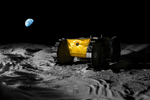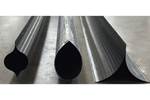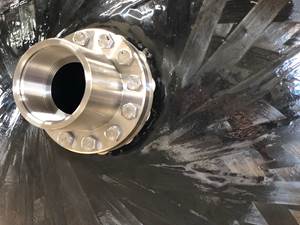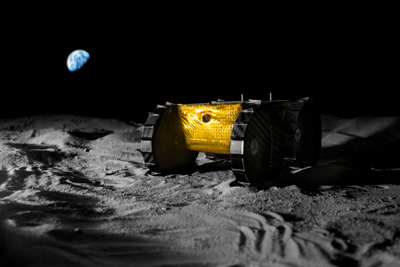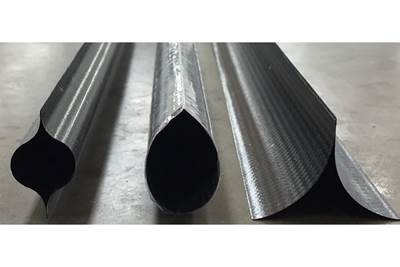ÉireComposites to develop Ireland's first carbon fiber satellite optical instrument
Development and manufacture of three composite stray light baffles for the ESA’s ALTIUS satellite will assist in climate change research.
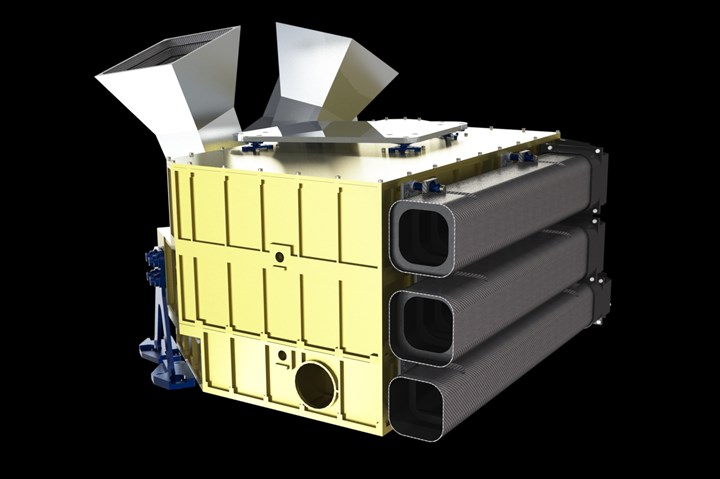
Front of the ALTIUS satellite. All photo credit: ÉireComposites
ÉireComposites (Galway, Ireland), an innovative design, manufacturing and testing company announced on March 1 an agreement with the Belgian defense and space company, (Oudenaarde, Belgium) to design and produce three carbon fiber stray light baffles, which will form part of the European Space Agency’s (ESA) ALTIUS satellite. According to ÉireComposites, the baffles will be the first external part and largest functioning piece of equipment manufactured in Ireland and launched into space.
With an expected launch by the end of 2023 from French Guiana, an overseas department of France on the northeast coast of South America, the ALTIUS satellite mission will deliver profiles of the Earth’s stratospheric ozone, as well as profiles of other atmospheric trace gases. This will provide scientific understanding on how the rise in greenhouse gases affects the atmosphere, and place a large role in how we view climate change.
The stray light baffles themselves, which will be attached to the side of the satellite, will prevent out-of-field stray light from reaching the lenses of the satellite’s optical instruments; a system with periscope mirrors will be used to align the light. ÉireComposites notes that stray light baffles rely upon highly controlled and precise manufacturing and finishing.
“The ALTIUS satellite will signal a major milestone for Irish participation in space exploration, as the three stray light baffles will become the first optical instruments manufactured in Ireland and the largest satellite parts manufactured in this country,” says Tomás Flanagan, ÉireComposites CEO. “I am delighted that OIP wants to work with ÉireComposites on this project. This is a massive achievement for the company and I hope this will be the first of many parts we manufacture for space exploration missions.”
He adds: “The ALTIUS mission will play a substantial role in how we look at climate change and the impact it has on Earth. The mission will allow for long-term monitoring and scientific study of the protective ozone layer which covers Earth and inform decisions around climate change. I am excited that we will be part of this research and I would like to take the opportunity to commend the team here in Inverin that have contributed to our success in obtaining this contract.”
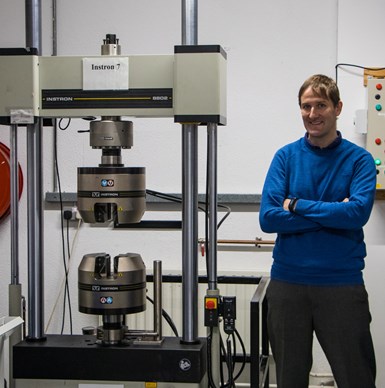
Tomás Flanagan, CEO of ÉireComposites.
The work ÉireComposites is undertaking is funded by the ESA with support from Enterprise Ireland, responsible for supporting Irish businesses. The company says winning this work was possible because of its history and close collaboration with the ESA, carrying out research and development in materials and processes, a focus ÉireComposites has maintained over the last decade. Notable projects include the development of a novel grid-stiffened lattice demonstrator for a launch vehicle in conjunction with ATG Innovation (Galway, Ireland), an engineering services company to the European Space sector.
According to Tom Kelly, manager of the Innovation and Competitiveness Division at Enterprise Ireland, this contract demonstrates the capacity of Irish technology companies to compete in the challenging space market, and the ongoing investment in the European Space Agency.
“ALTIUS is an important, challenging and very interesting project, allowing our company to contribute to actual studies related to climate change,” concludes Freddy Versluys, CEO of OIP. “The objective is to provide means to monitor the Earth’s atmosphere. OIP, being the industrial prime contractor for the payload, is responsible for the design, integration, alignment and testing of the ALTIUS instrument. We gladly announce that ÉireComposites was carefully selected as our new associate to handle the carbon fiber baffles part, in order to assist us in the further progress of the project. We trust to establish a solid working cooperation with fruitful, positive results. Good luck to our new partner!”
Related Content
Carbon fiber, bionic design achieve peak performance in race-ready production vehicle
Porsche worked with Action Composites to design and manufacture an innovative carbon fiber safety cage option to lightweight one of its series race vehicles, built in a one-shot compression molding process.
Read MoreBladder-assisted compression molding derivative produces complex, autoclave-quality automotive parts
HP Composites’ AirPower technology enables high-rate CFRP roof production with 50% energy savings for the Maserati MC20.
Read MoreWelding is not bonding
Discussion of the issues in our understanding of thermoplastic composite welded structures and certification of the latest materials and welding technologies for future airframes.
Read MoreInfinite Composites: Type V tanks for space, hydrogen, automotive and more
After a decade of proving its linerless, weight-saving composite tanks with NASA and more than 30 aerospace companies, this CryoSphere pioneer is scaling for growth in commercial space and sustainable transportation on Earth.
Read MoreRead Next
Composites design helps nano-sized lunar rover hit big milestones
Developed by Carnegie Mellon University, the ultralight, composites-intensive Iris nano-rover will make its lunar debut later this year.
Read MoreAnalySwift and University of Central Florida work with NASA to develop thin-ply composites
Materials will be characterized and performance modeled for wide array of aircraft and space applications.
Read MoreScaling up, optimizing the flax fiber composite camper
Greenlander’s Sherpa RV cab, which is largely constructed from flax fiber/bio-epoxy sandwich panels, nears commercial production readiness and next-generation scale-up.
Read More
